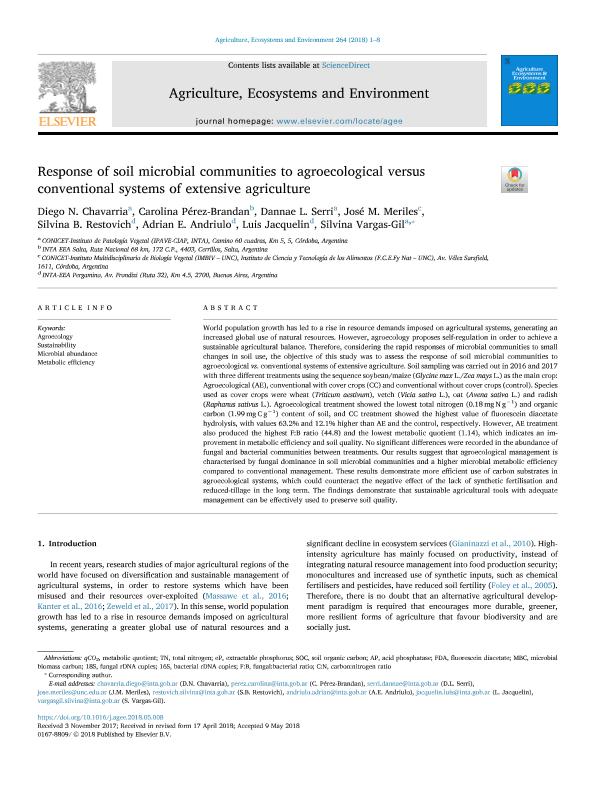Mostrar el registro sencillo del ítem
dc.contributor.author
Chavarría, Diego Nicolás

dc.contributor.author
Perez Brandan, Carolina Gabriela

dc.contributor.author
Serri, Dannae

dc.contributor.author
Meriles, Jose Manuel

dc.contributor.author
Restovich, Silvina Beatriz

dc.contributor.author
Andriulo, Adrian Enrique

dc.contributor.author
Jacquelin, Luis
dc.contributor.author
Vargas Gil, Silvina

dc.date.available
2019-11-04T16:45:06Z
dc.date.issued
2018-09
dc.identifier.citation
Chavarría, Diego Nicolás; Perez Brandan, Carolina Gabriela; Serri, Dannae; Meriles, Jose Manuel; Restovich, Silvina Beatriz; et al.; Response of soil microbial communities to agroecological versus conventional systems of extensive agriculture; Elsevier Science; Agriculture, Ecosystems and Environment; 264; 9-2018; 1-8
dc.identifier.issn
0167-8809
dc.identifier.uri
http://hdl.handle.net/11336/87899
dc.description.abstract
World population growth has led to a rise in resource demands imposed on agricultural systems, generating an increased global use of natural resources. However, agroecology proposes self-regulation in order to achieve a sustainable agricultural balance. Therefore, considering the rapid responses of microbial communities to small changes in soil use, the objective of this study was to assess the response of soil microbial communities to agroecological vs. conventional systems of extensive agriculture. Soil sampling was carried out in 2016 and 2017 with three different treatments using the sequence soybean/maize (Glycine max L./Zea mays L.) as the main crop: Agroecological (AE), conventional with cover crops (CC) and conventional without cover crops (control). Species used as cover crops were wheat (Triticum aestivum), vetch (Vicia sativa L.), oat (Avena sativa L.) and radish (Raphanus sativus L.). Agroecological treatment showed the lowest total nitrogen (0.18 mg N g−1) and organic carbon (1.99 mg C g−1) content of soil, and CC treatment showed the highest value of fluorescein diacetate hydrolysis, with values 63.2% and 12.1% higher than AE and the control, respectively. However, AE treatment also produced the highest F:B ratio (44.8) and the lowest metabolic quotient (1.14), which indicates an improvement in metabolic efficiency and soil quality. No significant differences were recorded in the abundance of fungal and bacterial communities between treatments. Our results suggest that agroecological management is characterised by fungal dominance in soil microbial communities and a higher microbial metabolic efficiency compared to conventional management. These results demonstrate more efficient use of carbon substrates in agroecological systems, which could counteract the negative effect of the lack of synthetic fertilisation and reduced-tillage in the long term. The findings demonstrate that sustainable agricultural tools with adequate management can be effectively used to preserve soil quality.
dc.format
application/pdf
dc.language.iso
eng
dc.publisher
Elsevier Science

dc.rights
info:eu-repo/semantics/openAccess
dc.rights.uri
https://creativecommons.org/licenses/by-nc-sa/2.5/ar/
dc.subject
AGROECOLOGY
dc.subject
METABOLIC EFFICIENCY
dc.subject
MICROBIAL ABUNDANCE
dc.subject
SUSTAINABILITY
dc.subject.classification
Otras Ciencias de la Tierra y relacionadas con el Medio Ambiente

dc.subject.classification
Ciencias de la Tierra y relacionadas con el Medio Ambiente

dc.subject.classification
CIENCIAS NATURALES Y EXACTAS

dc.title
Response of soil microbial communities to agroecological versus conventional systems of extensive agriculture
dc.type
info:eu-repo/semantics/article
dc.type
info:ar-repo/semantics/artículo
dc.type
info:eu-repo/semantics/publishedVersion
dc.date.updated
2019-10-24T18:19:14Z
dc.journal.volume
264
dc.journal.pagination
1-8
dc.journal.pais
Países Bajos

dc.journal.ciudad
Amsterdam
dc.description.fil
Fil: Chavarría, Diego Nicolás. Instituto Nacional de Tecnología Agropecuaria. Centro de Investigaciones Agropecuarias. Instituto de Patología Vegetal; Argentina. Consejo Nacional de Investigaciones Científicas y Técnicas; Argentina
dc.description.fil
Fil: Perez Brandan, Carolina Gabriela. Instituto Nacional de Tecnología Agropecuaria. Centro Regional Salta-Jujuy. Estación Experimental Agropecuaria Salta; Argentina
dc.description.fil
Fil: Serri, Dannae. Instituto Nacional de Tecnología Agropecuaria. Centro de Investigaciones Agropecuarias. Instituto de Patología Vegetal; Argentina
dc.description.fil
Fil: Meriles, Jose Manuel. Consejo Nacional de Investigaciones Científicas y Técnicas. Centro Científico Tecnológico Conicet - Córdoba. Instituto de Ciencia y Tecnología de Alimentos Córdoba. Universidad Nacional de Córdoba. Facultad de Ciencias Químicas. Instituto de Ciencia y Tecnología de Alimentos Córdoba; Argentina
dc.description.fil
Fil: Restovich, Silvina Beatriz. Instituto Nacional de Tecnología Agropecuaria. Centro Regional Buenos Aires Norte. Estación Experimental Agropecuaria Pergamino; Argentina
dc.description.fil
Fil: Andriulo, Adrian Enrique. Instituto Nacional de Tecnología Agropecuaria. Centro Regional Buenos Aires Norte. Estación Experimental Agropecuaria Pergamino; Argentina
dc.description.fil
Fil: Jacquelin, Luis. Instituto Nacional de Tecnología Agropecuaria. Centro Regional Buenos Aires Norte. Estación Experimental Agropecuaria Pergamino; Argentina
dc.description.fil
Fil: Vargas Gil, Silvina. Instituto Nacional de Tecnología Agropecuaria. Centro de Investigaciones Agropecuarias. Instituto de Patología Vegetal; Argentina. Consejo Nacional de Investigaciones Científicas y Técnicas; Argentina
dc.journal.title
Agriculture, Ecosystems and Environment

dc.relation.alternativeid
info:eu-repo/semantics/altIdentifier/url/https://linkinghub.elsevier.com/retrieve/pii/S0167880918301981
dc.relation.alternativeid
info:eu-repo/semantics/altIdentifier/doi/https://doi.org/10.1016/j.agee.2018.05.008
Archivos asociados
